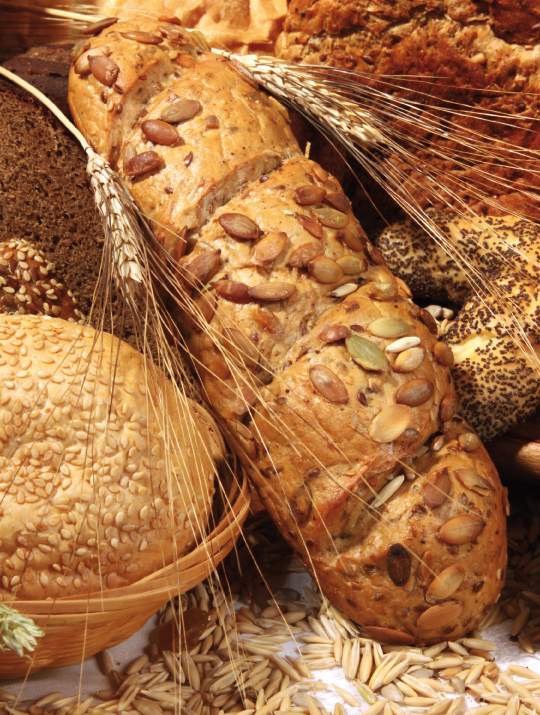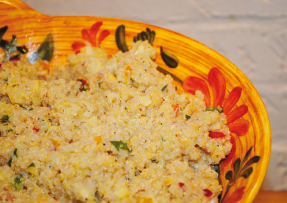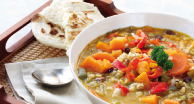Great Grains

 It’s never too late to make a resolution—or to follow through on a past resolution. We’ve all resolved to eat better (more fresh fruits and vegetables!), and are reminded to do so by recent changes to the U.S. Department of Agriculture’s dietary guidelines—revised from the Food Pyramid many of us grew up with (check out choosemyplate.gov). Twenty years ago, we were encouraged to reduce our meat intake, and pasta became the new center of the plate. Now, trends have changed, and we’re supposed to take it easy on refined carbohydrates like pasta, and instead reach more for whole grains.
It’s never too late to make a resolution—or to follow through on a past resolution. We’ve all resolved to eat better (more fresh fruits and vegetables!), and are reminded to do so by recent changes to the U.S. Department of Agriculture’s dietary guidelines—revised from the Food Pyramid many of us grew up with (check out choosemyplate.gov). Twenty years ago, we were encouraged to reduce our meat intake, and pasta became the new center of the plate. Now, trends have changed, and we’re supposed to take it easy on refined carbohydrates like pasta, and instead reach more for whole grains.
Whole grains are filling and satisfying, and keep us from filling up on less virtuous foods like cheese or meat. Substituting whole grains for refined grains helps us reduce the risk of heart disease, diabetes, stroke, osteoporosis, hypertension and obesity. Need any other reasons to increase the whole grains in your diet?
Whole grains are not just for breakfast, although oatmeal and whole grain cereals are great choices to add to your daily diet. Whole grains should be added throughout your day, and can easily be substituted in your favorite recipes—from simple substitutions like using steel-cut oats for white bread in meatballs and meatloaf, to more complex substitutions like interchanging wheatberries for pasta, or bulgur for risotto, in more advanced recipes.
 All grains come from cereal grasses and are the edible seeds of those grasses, composed of several different layers. The outer layer is generally inedible, and is removed. The next layer is the bran, rich in vitamins and minerals and soluble fiber. Under the bran is the germ—the part that sprouts—rich in enzymes, protein, minerals and vitamins. The starchy center (what is made into white flour) is called the endosperm. By the time we’ve removed all the outer coatings, the endosperm provides only carbohydrates—not many vitamins or minerals, and certainly no fiber. That’s why white flour has become such a villain in healthy diets.
All grains come from cereal grasses and are the edible seeds of those grasses, composed of several different layers. The outer layer is generally inedible, and is removed. The next layer is the bran, rich in vitamins and minerals and soluble fiber. Under the bran is the germ—the part that sprouts—rich in enzymes, protein, minerals and vitamins. The starchy center (what is made into white flour) is called the endosperm. By the time we’ve removed all the outer coatings, the endosperm provides only carbohydrates—not many vitamins or minerals, and certainly no fiber. That’s why white flour has become such a villain in healthy diets.
When buying whole grains, keep in mind that packaging can be misleading. Words like “natural” can mean nothing these days! Buy whole grains, read labels, and avoid processed (quick-cooking) or flavored grain mixes—they sometimes include added salt and sugar. Buy grains in bulk at natural foods stores or specialty foods stores, or sometimes even in the natural foods section of the grocery store. Look for stores that have good turnover; whole grains can go rancid if stored in warm conditions for a long period of time. As with most other ingredients, buy only what you need for the short term, and store the grains in a dark, cool pantry, or even the refrigerator or freezer if room allows.
Although full of nutty flavors, whole grains almost always benefit from cooking in a flavored liquid, like chicken or vegetable stock, with carrots, celery and onions to add even more flavor. Although grains like quinoa and wheatberries have existed since the beginning of time, they’re new in our kitchens, and so we’ve included a cooking guide for some of our favorites. And you can add some great grains to your diet this fall using these delicious recipes.
 Curry Quinoa Salad (Serves 4 as a side dish)
Curry Quinoa Salad (Serves 4 as a side dish)
Although this is great with quinoa, you could also substitute black rice (try the “Forbidden” brand) or wheatberries.
3/4 cup dried apricots, divided
2 1/3 cup water, divided
½ teaspoon curry powder
3 tablespoons rice wine vinegar
1 cup quinoa
½ cucumber, diced
½ red bell pepper, diced
Salt and pepper to taste
In a small saucepan, gently heat ½ cup apricots and 1/3 cup water to a simmer. Cover tightly and set aside for 10 minutes. Add curry powder and rice wine vinegar, and puree with a blender or food processor. Strain puree through a fine sieve and set aside.
Bring 2 cups water to a boil in a medium saucepan. Add the quinoa and cook for five minutes, stirring frequently. Cover and cook over low heat for 15 minutes until the water is absorbed. Cover tightly and let sit for 10 minutes, then fluff with a fork.
Toss vegetables and remaining apricots with quinoa and enough dressing to moisten. Season to taste. Serve with roasted chicken or fish.
Barley and Mushroom Soup (Serves 4-6)
½ ounce package dried mushrooms (morels are great!)
1 cup water
1 ½ tablespoons olive oil
1 large onion, diced
2 carrots, diced
2 stalks celery, diced
2 6-inch pieces fresh thyme
½ cup pearled barley
4 cups mushroom or beef broth
Salt and pepper to taste
Bring dried mushrooms to a boil in the water and let sit for 20 minutes in a covered pan. Strain liquid through a coffee filter to remove any grit, and set aside. Chop mushrooms.
In a large saucepan, sauté onions, carrots and celery in the olive oil until soft. Add thyme and barley and stir to coat with olive oil. Add stock and reserved mushroom water and bring to a simmer. Simmer for 20 minutes. Remove thyme pieces; season to taste with salt and pepper.







